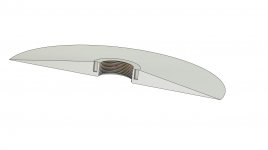Epic Metal
Plastic
- Joined
- Aug 17, 2014
- Location
- Medicine Hat, Canada
I am struggling machining a part, it is a approximately 9" diameter 316 SS disc approximately 5/8" thick with a taper on one face to a knife edge, max allowed rad on sharp od is .003", the center is a threaded through hole. I need the face opposite the taper to be flat to within .002". My process so far has been to waterjet cut a blank out of 3/4" plate, face one side and bore/thread the ID, then I take it to another cnc and spin it onto a fixture with the faced side to the fixture plate to hole it for the taper machining. The fixture plate works well, I have two small blind holes drilled near the threaded hole for a pin spanner to remove the disc from the fixture plate after this op is complete. Everything looks great until this point, after removing the disc I am seeing a ton of dish near the outer edge of the disc from the plate stress relieving itself and my original faced surface is concave by about .030". I would face it after but there would be a ton of chatter and I need a 64 finish max. I thought about making another fixture with a mating female taper but I can't really think of how to hold the disc to the fixture and be able to remove it after facing as it"ll be quite tight and my spanner won't be able to access the pin holes as they're on the wrong side of the part and aren't through holes. I have attached a picture not of the actual part just a cut away of a similar design so you understand what it is I am trying to make... I have alot of these to make, not a huge panic for time frame but want to get a system dialed in, perhaps grinding the flat face after machining the taper, the OD tolerance is loose at +/- .04" and the taper face isn't critical for flatness... Thoughts?? Perhaps machining from round instead of plate would prevent some of the stresses coming out of the plate once out of the fixture?


